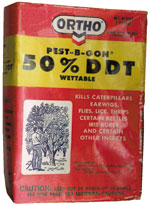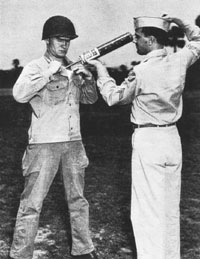|
|
|
 |
|
|
|
Mosquitoes, DDT, and Human Health
A leading entomologist describes the death and suffering caused by insect-borne diseases, and tells why we must bring back DDT.
(Excerpts of text from Fall 2002 issue of 21st Century)
by J. Gordon Edwards, Ph.D.
|
|
|
|
|
|
|

Anopheles, the mosquito that carries malaria, which today kills 2 to 3 million people a year.
(Pan American Health Organization/World Health Organization )
|
During the war in Europe, in 1944, we went to sleep every night while being fed upon by bedbugs and fleas, and there was no way to escape them. We had heard about “cooties” (body lice) causing typhus, which killed more than 3 million people in Europe and vicinity during and after World War I.
One day, I was ordered to dust every soldier in our company with an insecticidal powder that had just been received. For two weeks I dusted the insecticide on soldiers and civilians, breathing the fog of white dust for several hours each day. The body lice were killed, and the DDT persisted long enough to kill young lice when they emerged from the eggs.
Fortunately, no human beings have ever been harmed by DDT. I later learned that the material was produced by a German chemist, Othmar Zeidler, in 1874. He had made hundreds of chemical compounds but he never suggested uses for any of them. Sixty years later, in Switzerland in 1939, Dr. Paul Müller was seeking chemicals that might kill insect pests, and he followed Zeidler’s written directions for preparing several compounds. One of them was a compound that Zeidler had labelled dichlorodiphenyl-trichloroethane. Müller called it “DDT,” and in 1948, he received the Nobel Prize for his work with that chemical.
Dr. Joseph Jacobs later described his role in producing the first DDT made in the United States. At Merck & Company in New Jersey, he was assigned the task of duplicating Zeidler’s procedure, but on a much larger scale. He commandeered a huge glass-lined reactor, and produced the first 500 pounds of DDT made in the United States. An Army truck rushed it to an airport, and it was flown to Italy, where it halted a developing epidemic of typhus in our troops. The Surgeon General telegrammed thanks from President Roosevelt, and stating: “It is estimated that 5,000 lives were probably saved by destroying the typhus-carrying body lice infesting our soldiers.”1
After the war, I entered Ohio State University to study entomology. Insects are the most abundant forms of life on Earth; fortunately, only about 1 percent of them compete with human beings for food, fiber, and space. A small part of that 1 percent threatens our health with stings or bites, and a few transmit serious diseases.
I received my Ph.D. for research on beetles, and was hired to teach entomology at San Jose State University in California. There I spent much time studying parasitic insects, and taught medical entomology courses for more than 30 years. In addition to louse-borne typhus, our students were required to learn about diseases caused by mites, ticks, fleas, kissing bugs, black flies, chiggers, sand flies, eye gnats, tsetse flies, and mosquitoes.
|
|
|

DDT has saved more millions of lives than any other man-made chemical.
(Courtesy of Gordon Edwards)
|
Insect-borne Killer Diseases
At least 80 percent of human infectious diseases are arthropod-borne—transmitted by insects, mites, or ticks.2 They have caused the death of hundreds of millions of people by infecting them with the pathogens that cause typhus, bubonic plague, yellow fever, malaria, dengue fever, sleeping sickness, encephalitis, elephantiasis, leishmaniasis, and yaws.
Flea-borne Diseases
Typhus. In Europe there have been more than 150 typhus epidemics. During the Thirty Years’ War, typhus reduced the population from 30 million to just 13 million, killing 14 times more people than died in battle.
Scientists named the pathogen that causes typhus Rickettsia prowazeki, after two researchers who lost their lives because of their work: While studying a Mexican typhus epidemic, Howard Ricketts died of typhus three weeks after becoming ill, and Stanislas von Prowazek died of typhus in Poland.
The Saturday Evening Post, in an August 1942 article titled “Blitz Plague,” referred to the body louse as “the mass killer which has slaughtered 200 million people in Europe and Asia alone, diverted the stream of history, and done more than any other single factor to determine the outcome of wars.” It reported:
This year, in the Polish town of Vilna, where typhus once killed 20,000 of Napoleon’s troops retreating from Russia, railway employees were forbidden to approach trainloads of infected German soldiers returning from the Russian front. When infected, a person’s fever often reaches 107 degrees, with excruciating headaches and delirium. Mortality rates may be as high as 70 percent.
Bubonic plague. In the 14th Century, fleas that sucked blood from sick rats ingested pathogenic bacteria that were later named Pasteurella pestis. When those fleas then bit humans, they transmitted bubonic plague to them. That plague (the “Black Death”) killed one-fourth of the population of Europe and two-thirds of the population of the British Isles.
|
|
|

U.S. Department of Agriculture
In World War II, troops and refugees were dusted with DDT powder to kill the lice that carried typhus.
|
Mosquito-borne Diseases
Mosquitoes have been the worst of all the disease carriers!
More than 3,000 species of mosquitoes have been described in scientific journals. Most of them are in tropical areas, where as many as 150 species have been found in a single square mile. The United States contains about 170 species, Canada 70, and Arctic lands less than two dozen. In the Canadian Arctic, researchers who bared their arms, legs, and torsos in an experiment reported as many as 9,000 bites per minute. Unprotected human beings there could lose half of their blood in two hours, and die. Hundreds of cattle and horses have been killed by just such exsanguination, in our southeastern states.
Yellow Fever is caused by a virus transmitted by Aedes aegypti mosquitoes. Perhaps the disease was brought into America with slaves in the 1500s, but it also could have originated in monkeys in Central America, which still harbor it.
The name of this disease refers to the yellowing of skin that results after the infected mosquito bites. After a 10-day gestation period, there is a sudden onset of fever, with aching, nausea, bleeding from digestive tract, lungs, nose, and mouth, and severe vomiting (frequently bloody). Mortality rates from yellow fever often exceed 50 percent of the cases.
In 1542, Hernando DeSoto suffered with it and almost half of his troops died of it, in what is now the state of Florida. In 1741, England sent Admiral Edward Vernon with 27,000 men to Mexico and the Louisiana Territory. They retreated after 20,000 were killed by yellow fever. In 1802, Napoleon’s brother-in-law, Charles LeClerc, came to the Louisiana Territory with 33,000 soldiers, but gave up after 29,000 of them died of yellow fever.
Napoleon had envisioned a French colonial empire in the New World, but after such severe losses he did an about-face and sold the Louisiana Territory to the American colonists for $15 million, nearly doubling the size of our country. Some historians say that the sale was a result of yellow fever killing 40,000 French troops.
In 1900, in Cuba, the U.S. Yellow Fever Commission investigated the disease, under the guidance of Walter Reed, James Carroll, Jesse Lazear, and A. Agramonte. Their research with human volunteers proved that the fever was transmitted only by the bites of Aedes aegypti mosquitoes, rather than by personal contact.3 Attempts to eradicate those mosquitoes almost succeeded in Central America and the Caribbean, but failed in southeastern United States, where Aedes aegypti still abound. Their larvae thrive in junk yards and auto wrecking yards, where they live in used tires and other small containers of water.
Yellow fever vaccines have been available since 1942, but must be kept refrigerated. That is a problem in hot countries, especially because Freon was unwisely banned by pseudo-environmentalists in the great ozone hoax. More than 400 million people have been given the vaccine.
In Central America a pretty native mosquito, Haemagogus spegazinii, transmits the virus from monkey to monkey in the tree tops. If a tree falls in the jungle and human beings are nearby, the Haemagogus can transmit the virus to them. These individuals may then serve as reservoirs of the fever in their villages.
Encephalitis Viruses. Mosquitoes transmit many other kinds of viruses, causing illnesses such as Eastern Equine Encephalitis (EEE), Western Equine Encephalitis (WEE), St. Louis Encephalitis (SLE), Japanese B Encephalitis (JBE), Venezuelan Equine Encephalitis (VEE), and West Nile Encephalitis. An epidemic of SLE in 1933 devastated St. Louis and several other cities as far east as Louisville, Ky. More than 1,000 cases there resulted in 266 deaths.
Japanese B Encephalitis has been very deadly in Japan and Korea. In 1924, Tokyo had 6,000 cases, and 3,800 died. In 1948, Japan had 8,000 cases and 4,750 died. The vector, the Asian Tiger mosquito (Aedes albopictus), is now well established in the United States, and has already transmitted fever viruses to children in southeastern and midwestern states, and in Texas. Transovarial transmission may pass encephalitis viruses from female mosquitoes to their larvae, via infected eggs.
Dengue Fever is also known as “Breakbone Fever” because the virus causes extreme aching of joints, even the joints between plates in the skull. Many kinds of mosquitoes transmit the virus, but Aedes aegypti is the major vector. In Guam, 98 percent of the American troops were infected. Some of my students served with the U.S. Navy and had been infected with dengue. They told me that the pain was “indescribable,” and one said: “When I had malaria I was afraid I might die, but when I had dengue I almost wished that I could die.” The only medication they had was aspirin, which gave very little relief.
In addition to the fever and other symptoms, the dengue virus causes great pain in the eyes, “like someone has his fingers behind your eyeball and is trying to pull it out.” A first exposure to dengue is not often fatal, but re-exposures are more serious, with about 15 percent mortality caused, especially in children
The Asian Tiger Mosquitoes, Aedes albopictus, are efficient carriers of the dengue virus. When they first invaded Brazil, there were only 6 dengue cases in Rio de Janeiro (in 1985). In just one year, the mosquitoes spread the fever to 350,000 people! In 1985, some of these mosquito larvae were shipped into Houston Texas from Japan, in old automobile tires—they can breed successfully in as little as a quarter inch of water. In Evansville, Indiana, they were also breeding in piles of old tires. The piles were sprayed with insecticides every day, for 11 days, but swarms of adult mosquitoes still emerged. In early July 2001, Tiger Mosquitoes were found in the San Francisco Bay area of California. They had just arrived from China, in a shipment of live bamboo plants. The larvae had matured in the water surrounding the plant roots. This mosquito will probably extend its range from coast to coast, and many encephalitis cases should be anticipated. . . .
|
|
|

The author, featured in Esquire magazine, September 1971, eating a tablespoon of DDT, a feat he repeated publicly almost every week in his public campaign to show the safety of DDT.
(Courtesy of J. Gordon Edwards)
|
DDT: Safe, Effective, and Inexpensive
To control Anopheles mosquitoes, DDT was sprayed on inside walls once or twice a year. In 1959, spraymen applied 60,000 tons of DDT to the inside walls of 100 million houses. There was never any need to wear masks or protective clothing while doing DDT spraying. No adverse effects were ever experienced by the 130,000 spraymen or the 535 million people living in the sprayed houses.8
In house spraying, the amount applied was 2 grams of DDT per square meter of wall, every 6 months.9 Also, no wildlife was injured by DDT in those areas. The World Health Organization Director concluded, “The discontinuation of the use of DDT would be a disaster to world health.”
Montrose Chemical Company workers in California, who wore no masks or goggles, were never harmed by their constant exposure to DDT. When their fatty tissues were analyzed, they were found to contain up to 647 parts per million (ppm) of DDT residues. The fatty tissues of the general population at that time contained only 5 or 6 ppm of DDT.10 There were no cancer cases in those workers, even after 1,300 man-years of heavy daily exposure to DDT. Dr. Edward R. Laws, of the U.S. Public Health Service, found that those Montrose workers still were healthy after 10 to 20 years of that exposure.
In addition to its effectiveness, DDT is inexpensive. The cost of spraying in 1959 was $205,000, but if substitutes had to be used, malathion would have cost $637,000, and propoxur would have cost $1,762,000 for the same control. A 1.5 oz. whisky jigger full of 70 percent wettable DDT covers 144 square feet of wall surface, killing all mosquitoes that land there during the next six months.
In the 1960s, the World Health Organization tested more than 1,300 pesticides, seeking effective substitutes for DDT in mosquito control. Only four approached DDT’s effectiveness: Malathion, Aprocarb (Baygon), fenthion, and fenitrothion, but all were more hazardous to humans than DDT and were 4 to 20 times more expensive than DDT.11
Because, over the years, I kept hearing propagandist claims that DDT is toxic to people, I studied all of the relevant scientific and medical literature. Here I mention only some details on DDT’s safety:
Evidence That DDT Fights Cancer
• Drs. Charles Salinskas and Allan E. Okey reported that DDT in rodent diets inhibited development of induced mammary cancers and leukemia.13
• A.E. and E.K. McLean determined that after animals had ingested DDT, the highly toxic aflatoxins they had been fed were not fatal, perhaps because they were converted to non-toxic metabolites by the liver.14 DDT was also known to induce the formation of hepatic microsomal enzymes which, in turn, inhibited the growth of tumors and cancers.
Dr. Wayland Hayes performed tests for the U.S. Public Health Service, feeding human volunteers up to 35 milligrams of DDT in their food every day for 18 months. (The average human intake of DDT in the United States at that time was about 0.03 mgs per day, or 0.36 mgs per year.)15 No adverse effects resulted, either at the time of the study, or during the next 10 years.
As a result of such studies, I felt that it was safe for me to ingest DDT. I was delivering addresses to various audiences almost every week. I carried a commercial box of DDT onto the stage, dug out a tablespoon of DDT (about 12 mgs), swallowed it, and washed it down with water before beginning my talk about DDT’s lack of toxicity to vertebrate animals. Esquire magazine, in September 1971, pictured me ingesting a tablespoon of DDT. The text explained that I had “eaten two-hundred times the normal human intake of DDT, to show it’s not as bad as people think.”
At the same time, the pseudo-environmentalists were going wild against DDT. Clifton Curtis of the World Wildlife Fund, for example, wrote that “DDT is so potent that as long as it is used anywhere in the world, nobody is safe”—and provided no data to back up his assertion. Dr. Gilbert L. Ross, of the American Council on Science and Health, characterized Curtis’s remarks as “typical of the dangerous environmental disinformation masquerading as science that has been stirring DDT hysteria ever since the 1960s.” Ross pointed out that “Extensive scientific studies have not found any harm to humans, even during the massive overuse of DDT in agriculture in the 1950s and 60s.” Furthermore, the scientific reports show that there is no indication of DDT use harming people, birds, bird eggshells, or other vertebrate animals.16
During the 1960s, the World Health Organization proposed the possible eradication of malaria, worldwide, and malaria control was achieved in areas with a population of 279 million people. Thirty-six formerly malarious countries totally eradicated the disease. The U.S. National Academy of Sciences stated in 1970:
To only a few chemicals does man owe as great a debt as to DDT. In little more than two decades DDT has prevented 500 million human deaths, due to malaria, that would otherwise have been inevitable. . . .17
|
|
|
|
|
|
|
|
|